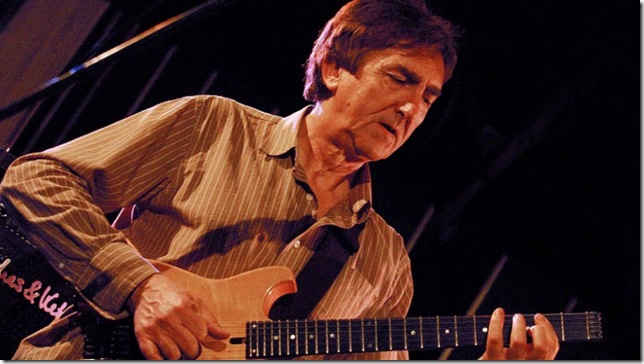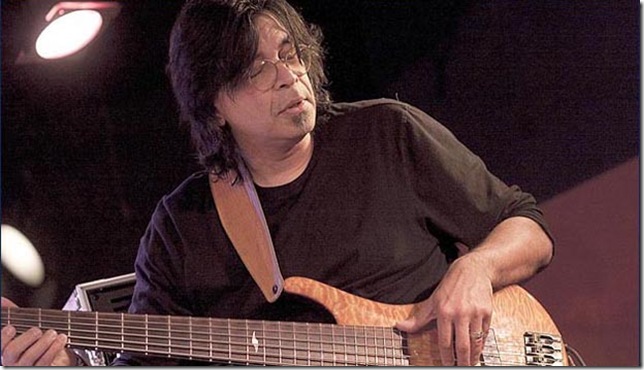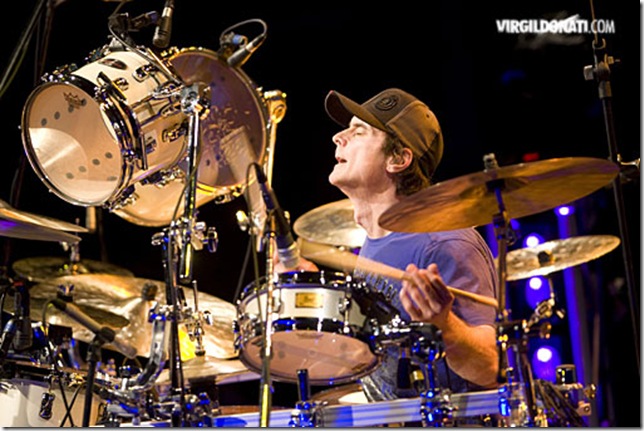The unofficial title of “World’s Greatest Living Electric Guitarist” automatically eliminates late American contenders like rocker Jimi Hendrix, blues man Stevie Ray Vaughan, and the inimitable Frank Zappa. So the crown likely boils down to several prominent British veterans who’ve dipped at least a toe into challenging progressive music.
Among them is the 1960s Yardbirds rock trilogy of Eric Clapton, Jeff Beck and Jimmy Page. Of those, Beck would later venture furthest into instrumental jazz/fusion, where the 71-year-old’s influence remains significant. A fellow Englishman, 73-year-old John McLaughlin, rose to prominence in that genre, ranging from early fusion with Miles Davis to warp-speed electric music with the Mahavishnu Orchestra and Middle Eastern structures with Shakti.
And then there’s 69-year-old Allan Holdsworth.
Why would he stand alone? Because he’s a non-singing instrumentalist whose influence is arguably matched among these guitarists only by Hendrix and Clapton, both of whom were rock-and-blues-based vocalists. The right-handed Holdsworth’s left hand is a microcosm of what sets him apart, since it fuels a liquid, two-handed legato attack that’s unlike the approach of these other greats, who primarily use their non-picking hands only to dictate the notes on their fret boards.
“The legato element is because I actually wanted to play the saxophone,” Holdsworth says by phone from his adopted hometown of San Diego, “but we didn’t have enough money to afford one. My father was a fine pianist, and my only real teacher. So when I got a cheap guitar from an uncle, and my dad saw I was still interested in it a few months later, he said he would get me some books and teach me some theory. But I still found myself trying to make the guitar sound more horn-like than what I was used to hearing.”
There are ample other elements in Holdsworth’s arsenal, all of which will be on display when the guitarist visits Florida — for the first time since the 1980s — to play a mini-tour that includes the black box theater at the Mizner Park Cultural Arts Center in Boca Raton on Nov. 21. He’ll play with his touring trio of the past few years, featuring bassist Jimmy Haslip and drummer Virgil Donati.
“There are many unusual aspects to Allan’s playing,” says the Los Angeles-based Haslip, 63, best-known for a 32-year tenure with fusion icons the Yellowjackets. “From his physical technique to his knowledge of harmony, to how he hears his guitar during chords and soloing, and how he hears the overall music in his head, which includes song structure, phrasing and melodies. And all are connected to his instinctual and creative ideas, and how he personally internalizes everything and expresses his emotions. All extremely unique, and distinctly one of a kind.”
Holdsworth’s facility on the instrument is revered by notable younger guitarists in a surprisingly wide range of genres, including progressive rocker Alex Lifeson of Rush, fusion icon Scott Henderson, instrumental rocker Joe Satriani, jam band hero Jimmy Herring of Widespread Panic, and a wide swath of traditional jazz players from Stanley Jordan to Kurt Rosenwinkel to Jonathan Kreisberg.
Eddie Van Halen was so wowed by Holdsworth’s two-handed attack that he convinced Warner Bros. to release one of his EPs, Road Games, in 1983 — a rarity within a career that includes only 12 solo efforts, most self-released or on smaller, independent labels. Even Zappa, never one to dole out compliments to himself or anyone else, took notice, calling Holdsworth “one of the most interesting guys on guitar on the planet.”
Perhaps that interest stems from the fact that Holdsworth’s advanced technique didn’t surface via the expected traditional music school route. Born in Bradford, West Yorkshire in 1946, the guitarist grew up appreciating recordings by guitar torch-bearers Django Reinhardt, Charlie Christian and Joe Pass, as well as saxophonist John Coltrane. In addition to his fluid approach a la a sax or piano, Holdsworth also plays the violin.
“A lot of us start out on guitar, but study piano players later on,” says Holdsworth. “My father had a huge record collection, and taught me from a piano standpoint, which kind of took me down a different path from the start.”
His early exposure with jazz saxophonist Ray Warleigh and drummer John Hiseman’s progressive rock band Tempest led to Soft Machine, an avant-garde British group that showcased its guitarist’s mercurial abilities, both live and on the 1974 album Bundles. While most of the world hadn’t yet taken notice, a significant portion of the planet’s most influential musicians certainly had.
The Holdsworth aura expanded exponentially from the mid-’70s through mid-’80s, largely through the tributaries of the artists and bands he recorded sessions with. One was the since-deceased drumming meteor Tony Williams (1945-1997), who’d been part of Miles Davis’ great mid-1960s quintet while still a teenager before forming his influential Lifetime trio, with McLaughlin on guitar and Larry Young on organ, in 1969.
When that trio disbanded, Williams created the New Tony Williams Lifetime, with Holdsworth, keyboardist Alan Pasqua, and bassist Tony Newton. The quartet’s 1975 debut, Believe It, was a funky, explosive, instrumental jazz-meets-rock U-turn away from the preceding trio’s more jam-based approach. One tune, “Fred,” featured a spark-to-simmer-to-boil middle Holdsworth solo that few other guitarists could’ve conceived of, let alone executed.
“‘Believe It,’ in my opinion, is the quintessential jazz/fusion recording of its era,” Haslip says.
The album also inadvertently allowed Holdsworth and Haslip to meet for the first time.
“We met in the mid-’70s,” says Haslip, “when I was playing in guitarist Tommy Bolin’s band and we opened for the New Tony Williams Lifetime. Quite a coincidence, I’d say.”
That coincidence wouldn’t emerge for 30 years, though. Haslip (now an in-demand producer who’s engineered more than 25 projects in the past few years) started playing with guitarist Robben Ford not long thereafter, planting seeds that sprouted the Yellowjackets, the gifted bassist’s band until 2012. And Holdsworth would go on a session tear through the rest of the ’70s, playing on violinist Jean-Luc Ponty’s 1977 gem Enigmatic Ocean and two underrated efforts by Swedish drummer Pierre Moerlen’s band Gong, Gazeuse! (1976) and Expresso II (1978).
Also in 1978, Holdsworth joined forces with another drumming legend who’s started his recording career in his teens. Fellow Brit Bill Bruford had been in the ground floor of progressive rock icons Yes, and had spent the previous several years with the like-minded if significantly darker prog-rockers King Crimson. Holdsworth played on Bruford’s 1978 solo debut, Feels Good To Me, which also featured the creative contributions of keyboardist Dave Stewart and bassist Jeff Berlin.
Later that year, Bruford formed the supergroup U.K. by recruiting his King Crimson rhythm section partner, bassist/vocalist John Wetton, along with Holdsworth and keyboardist/violinist Eddie Jobson (Zappa, Roxy Music). Its self-titled debut was an incendiary masterpiece of largely improvised playing, yet that’s exactly what split the band into two camps, and necessitated that U.K. carry on afterward as a trio with no guitarist (and Terry Bozzio replacing Bruford). Jobson and Wetton actually wanted Holdsworth to replicate the same notes during his solos at every live performance, rather than improvise, in the name of commercial success. The bassist later got his wish with a predictable supergroup called Asia.
Yet Bruford’s second solo effort, 1979’s One of a Kind, proved a masterpiece. The drummer’s playing and compositions were top-shelf; Berlin proved to be one of the few ’70s bassists who were legitimately compared to Jaco Pastorius, Stewart utilized synthesizers without the over-processed syrup factor, and Holdsworth provided the lightning strikes.
“Besides ‘Believe It,’” says Haslip, “Allan’s other session recording I’d pick from that era would be Bruford’s ‘One of a Kind.’”
Ever conscious of artistic control and seemingly never satisfied with his own playing, Holdsworth didn’t officially start his solo recording career until 1982 with the independently released album I.O.U., featuring his former Tempest vocalist Paul Williams, bassist Paul Carmichael, and uber-talented drummer Gary Husband (who now doubles on keyboards with McLaughlin’s quartet). The Van Halen-inspired EP Road Games, produced by longtime Van Halen engineer Ted Templeman, yielded a Grammy nomination for Best Rock Instrumental Performance, yet Holdsworth’s differences with Templeman necessitated a return to smaller labels.
Standout CDs since include the molten Metal Fatigue (1985), Haslip’s favorite, Sand, from 1987, on which Holdsworth utilized an additional guitar-synth controller called a SynthAxe (which he continues to use), and Secrets (1989), with the one-of-a-kind contributions of former Zappa drummer Vinnie Colaiuta.
The guitarist’s output slowed starting in the 1990s, yet the rekindling of the relationship between Holdsworth and Haslip finally occurred within the last 10 years — and appears to have jump-started a legendary if underrated career. And the warhead was the association with the late drummer Williams.
“I got the call in late 2006 to sub for Alphonso Johnson on a three-week tour of Europe,” Haslip says, “with Allan Holdsworth, Alan Pasqua and drummer Chad Wackerman. There were more gigs in Japan, Europe and the United States in 2007. Eventually, Pasqua collected a series of quality board mixes, and reached out to us to say we might have a live recording in the can. That was the beginning of the double-live CD ‘Blues For Tony.’”
Dedicated to Williams, the stellar 2009 concert recording includes not only “Fred,” but the other Believe It standouts “Red Alert” and “Proto Cosmos,” all of which are also still played in the trio with Haslip and Donati. Blues For Tony was released by MoonJune Records, the label headed by Leonardo Pavkovic, who’s also Holdsworth’s manager.
“There were already illicit recordings of those shows being passed around,” Holdsworth says, “so Alan felt we should do a ‘beat the boots’ release of our own.”
A successful PledgeMusic online campaign has fueled Tales From the Vault, a collection of outtakes from Holdsworth’s previously recorded sessions that he’s putting the finishing touches on. There’s also a brand-new studio effort, to be called Insomniac and released through guitarist Steve Vai’s Favored Nations label.
It’ll feature bassists Jimmy Johnson, Anthony Crawford and Haslip, plus the 57-year-old Australia-born Italian Donati on drums on all tracks. A tune from that release, “Cygnus,” is in the trio’s repertoire for its forthcoming trio tour, along with older Holdsworth solo faves like “Material Real,” “Letters of Marque,” “Pud Wud,” “Looking Glass” and “Water on the Brain Pt. 2.”
“I figured Virgil was the perfect drummer to kick me in the butt at this stage of my career,” says Holdsworth with a laugh. “He’s a tremendous drummer and a great guy. I love playing in the trio with Virgil and Jimmy. They’re fantastic musicians.”
The ever-anal Holdsworth admits that he would have more authorized live CDs than three, and studio releases than 12, over a 30-plus-year recording career if he weren’t so meticulous as both a musician and producer.
“I’m obviously not the fastest guy when it comes to making records,” he says. “All the basic tracks are done for ‘Insomniac,’ but I have to get my parts down. And I’ve probably always erased more stuff than I’ve kept!”
Jazziz magazine presents Allan Holdsworth, Jimmy Haslip and Virgil Donati in 8 and 9:30 p.m. shows on Nov. 21 at the Mizner Park Cultural Arts Center, 201 Plaza Real, Boca Raton ($30 plus fees, 561-405-4254).


